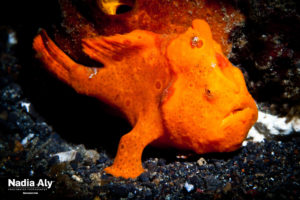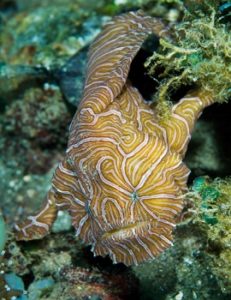What are frogfish?
 Frogfish are part of the anglerfish family, which includes several species. “Frogfish” is a common name that covers several distinct species as well, such as the common frogfish, the painted frogfish and the hairy frogfish.
Frogfish are part of the anglerfish family, which includes several species. “Frogfish” is a common name that covers several distinct species as well, such as the common frogfish, the painted frogfish and the hairy frogfish.
Their most common shared characteristics are their stocky bodies and camouflage abilities. Some species can grow up to 10 inches (25 cm), but they are often quite small. They come in various colors and patterns and are expert at hiding on the reef while waiting for prey to swim by. They are solitary and seldom seen in pairs. Frogfish can swim just fine but are often seen “crawling” on the sea floor using their hand-like pectoral fins.
What do they eat?
Frogfish are predators that feed on small fish and crustaceans. Not only do they excel at hiding and waiting passively for prey, but they also actively lure creatures in with their rod, or illicium, which sits in the middle of their head. Atop the rod is a lure that mimics a small fish or a worm, and once the prey is close enough, the fish strikes with lightning speed. With its expandable jaw, one of these guys can easily swallow prey that’s much larger than itself.
How do they reproduce?
Both sexes look alike and there is no way to tell them apart underwater. There has been very little observation of reproduction. Scientists think that most species are free-spawning, wherein the female releases many eggs simultaneously, close to the surface and the male who has been waiting nearby fertilizes them. The eggs then float around and hatch within a few days, releasing tiny fish (about 1 mm) that will slowly grow into frogfish.
Where do they live?

Frogfish are common in many oceans, but species vary from one area to another. Their camouflage abilities often make them quite hard to spot. To increase your chances, ask your dive guide what common species and what colors they see most often, and then dive slowly and observe the reef carefully. It might look like a sponge, but if it has a small eyeball, it might be a frogfish. Their grouchy-looking faces make them a favorite among photographers, and some species, such as the hairy frogfish or the psychedelic frogfish, are quite rare, so consider yourself lucky if you see one of these distinctive critters.

